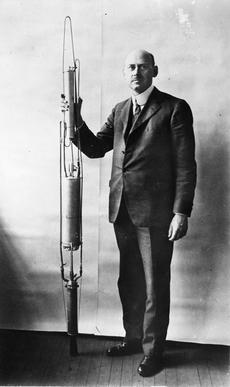Robert H. Goddard: American Rocket Pioneer
 Robert Hutchings Goddard (1882-1945) is considered the father of modern rocketry. One of Goddard's many firsts was the successful test of the world's first liquid-propelled rocket.
Robert Hutchings Goddard (1882-1945) is considered the father of modern rocketry. One of Goddard's many firsts was the successful test of the world's first liquid-propelled rocket.
Goddard was born in Worcester, Massachusetts, on October 5, 1882. He was often ill as a child and had extended absences from school. He attended college at the Worcester Polytechnic Institute where he received his BS in 1908. From there, he went on to Clark University where he earned his doctorate, taught physics, and began his experimentation with rockets.
Goddard was, in many ways, ahead of his time. His work was not understood by his colleagues, and he had great difficulty getting financial support for his experiments. By 1915, he was considering abandoning his work, since no one else seemed to think it promising.
Goddard's long relationship with the Smithsonian Institution began in September 1916 when he wrote a letter to the Institution describing his rocket experiments and requesting funds so he could continue with his work. This letter was received by then Assistant Secretary Charles Greeley Abbot. After reading the letter, Abbot considered Goddard's work as "sound and ingenious," and recommended to Secretary Charles Doolittle Walcott that the Smithsonian should support Goddard's work. On January 5, 1917, Walcott wrote to Goddard informing him that he received a $5,000 grant from the Hodgkins Fund for atmospheric research.
The Smithsonian continued supporting Goddard's research for many years, and not just with financial support. In 1919, the Smithsonian published Goddard's classic treatise "A Method of Reaching Extreme Altitudes in the Smithsonian Miscellaneous Collections" (Vol. 71, No. 2). This publication contains the basic mathematical theory underlying rocket propulsion and rocket flight.
Goddard often used Abbot as a sounding board for his ideas and his dreams for his rockets, one of which was the eventual investigation of space. In March 1920, he sent a report to the Smithsonian entitled "Report on Further Developments of the Rocket Method of Investigating Space." In this report, which he asked the Smithsonian not to make public at the time, Goddard set forth his ideas about the exploration of space with and without an "operator," or in other words manned and unmanned space flights.
Goddard was extremely grateful for the support the Smithsonian showed him over the years. In a letter dated May 28, 1930, Goddard wrote to Abbot stating that he was "particularly grateful for your interest, encouragement, and far-sightedness. I feel that I cannot overestimate the value of your backing, at times when hardly anyone else in the world could see anything of importance in the undertaking."
On March 16, 1926, Goddard successfully launched the world's first flight of a liquid-propelled rocket. This flight is often compared in its significance to the Wright Brothers first flight in 1903. Another important first came on July 17, 1929, when Goddard tested the first rocket to carry scientific instruments, with a barometer and camera on board.
Robert Goddard made great contributions to the development of rockets and space flight. He is credited with 214 patents, with 131 filed after his death. Goddard died on August 10, 1945, from throat cancer. On May 1, 1959, the National Air and Space Administration (NASA) established the Goddard Space Flight Center in Greenbelt, Maryland, in his memory.
CLASSROOM ACTIVITIES
PRIMARY SOURCES
- September 27, 1916 - Goddard's Proposal to the Smithsonian
- October 2, 1916 - Assistant Secretary Abbot to Secretary Walcott on Goddard's Proposal
- December 15, 1916 - Goddard Rocket Apparatus Patent
- December 16, 1916 - Assistant Secretary Abbot to Secretary Walcott on Goddard's Proposal
- January 5, 1917 - Secretary Walcott to Goddard Approving the Grant
- January 9, 1917 - Goddard to Secretary Walcott after Receiving Grant
- March 1920 - "Report Concerning Further Developments" in Space Travel
- May 5, 1926 - Report from Goddard to Assistant Secretary Abbot –The report includes Goddard's account of the March 16, 1926 test flight of the first successful liquid-propellant rocket.
- May 28, 1930 - Goddard to Secretary Abbot Thanking Smithsonian for Its Support
FURTHER EXPLORATION
- "Robert Goddard and the First Liquid-Propellant Rocket," National Air and Space Museum's Air/Space Blog
- Robert H. Goddard: American Rocket Pioneer, National Aeronautics and Space Administration, Goddard Space Flight Center
- "Robert Goddard and His Rockets", National Aeronautics and Space Administration in From Stargazers to Starships, by David P. Stern.
- Robert H. Goddard, Clark University, Archives and Special Collections
